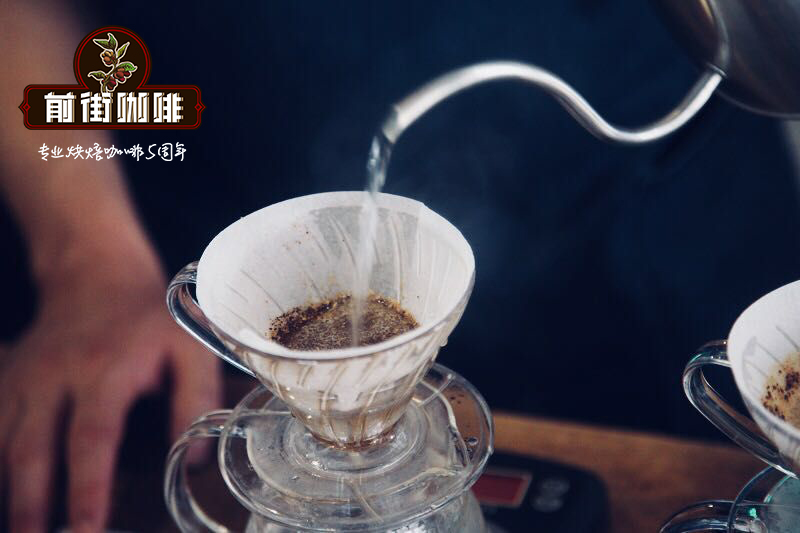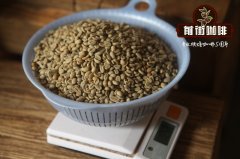How to choose the right temperature for hand-brewed coffee? why does it turn sour when it cools?

Have you ever enjoyed a cup of hot coffee, but noticed that once it starts to cool, its taste and aroma seem to change?
When this happens, you may begin to discover delicate and subtle flavors and aromas that you could not detect before. You may find that your coffee now has obvious sweetness, fruity or floral aroma.
The change in taste is caused by specific chemical reactions caused by temperature fluctuations. To understand why and how they happen, you need to understand the science behind them.
How do we view flavor and aroma?
Coffee is an incredibly complex drink. It contains more than 1000 aroma compounds that help us smell and taste aromas when brewing and eating. Of the 1000 compounds, 40 significantly promoted the aroma of coffee.
When temperature increases cause reactions with sugars, carbohydrates and nitrogen compounds in green beans, most of these aromatic compounds are produced during baking. As James Hoffman (James Hoffman) pointed out in his book "Coffee World Map" (The World Atlas of Coffee), sugar breaks down because of the high temperature of the baking process. At this point, they are either caramelized (producing the familiar smell of caramel) or brown through the Maillard reaction.
This process produces volatile compounds, which are converted into gases that evaporate at room temperature. Through this form, our ability to perceive them has been enhanced. We feel through the tongue and nose that these flavors and aromas are various aromatic compounds associated with sweetness. From chocolate to fruit.
Taste receptors for acidity, bitterness and sweetness are found on the cell surface of our tongues. They react to the presence of certain chemicals and then transmit this sense of flavor to our brains. Chemicals in volatile compounds spread from our mouth to our nose to stimulate the olfactory system; a collection of organs in the nasal cavity. This process is also essential for determining flavor and aroma.
When it comes to other flavors we think, a variety of organic acids, sugars, oils and caffeine help us taste. As Hoffman explains in the World Coffee Atlas, chlorogenic acid found in mung beans produces a bitter taste, while quinic acid produces a bitter taste.
I talked to certified Q-level students and coffee researcher Ver ô nicaBelchior, what that means. She explained to me that this understanding can be learned through association.
If there is sour taste in our coffee, it can increase our understanding of sour taste. This is because we learn volatile compounds related to basic flavors, so we often come into contact with lemon and sour flavors. Once we are together, people's perception will increase. "
How does temperature affect extraction?
We all know that extracting coffee has a great influence on the taste and aroma we feel when we drink coffee. Here, the temperature of brewing water will also have a significant impact on the extraction rate of coffee.
"each molecule has the best [extraction] according to the temperature of the water. Hot water can extract most of the compounds we feel in coffee, and. The hotter the water, the easier it is to extract compounds. " Ver ô nica interpretation.
As the water temperature rises, water molecules begin to get more energy from heat. They begin to move faster, increasing the interaction between water molecules and coffee molecules.
The more these two molecules interact, the more extraction occurs. When this happens, water molecules dissolve more compounds from coffee molecules, affecting our taste and smell in drinks.
Ver ô nica points out: "if we use low-temperature water, we will not extract [volatile] compounds that are interesting to fully perceive coffee."
However, studies have shown that for drinks such as cold drinks, the beverage will change when the drink is extracted for several hours at a time at a low temperature (22 °C to 5 °C).
Ver ô nica told me, "this leads to complex sensory characteristics because the extraction balance of most compounds is achieved. [Max. Extract sugars, organic acids, chlorogenic acids, caffeine and [and other] insoluble compounds that require [more] [extraction] time.
This kind of low temperature extraction for a long time can fully extract sugars to make a taste drink which is mainly sweet and caramel-flavored. Cold brewed coffee also tends to have a lower bitterness and astringency.
Flavor and aroma at high temperature
According to the National Coffee Association (National Coffee Association), the ideal coffee drinking temperature is 82 °C to 85 °C. However, because the temperature in this range may exceed your thermal pain threshold, it can burn your tongue. The most recognized method of time-consuming coffee is to "suck" it through small bites or cupping. Here, you only need to inhale a small amount of liquid and inhale air to quickly cool the liquid.
The flavor and aroma began to appear at about 76 °C. At this temperature, coffee releases a lot of steam, which can enhance your aroma, but suppress the flavor. Volatile compounds are released faster and evaporate faster here.
A high level of aroma can be felt at a temperature of about 70 °C and can be kept as low as 60.4 °C. These aromas are often described as "roasted", "earthy" and "strong". The taste is often difficult to understand here, especially when the coffee is more delicate. In fact, studies have shown that all kinds of coffee baked at similar levels are more likely to taste the same coffee at higher temperatures.
The taste we feel at 70 °C is mainly bitter, and like the aroma, the taste is related to intensity and baking taste.
These flavors will last until the coffee cools again at 10 °C, at which point we may find an increase in bitterness. It has been found that the bitterness is strongest at about 56 ℃.
Flavor and aroma during cooling
At a temperature below 50 °C, you will see a significant change in the flavor and aroma of the coffee. The aroma becomes harder to find. It is mainly due to the reduction of steam produced after the coffee is cooled.
The bitterness begins to decrease, so that more complex flavors can be reflected. The most flavor can be detected between 31 °C and 50 °C. These will be mainly those related to acidity and sweetness. The sweetest time is about 44 °C. Bitterness is the most difficult to detect at about 42 °C.
Minimal changes and the most interesting effects may occur between 31 and 37 °C. In this temperature range, the volatile compounds associated with sweet, fruity, floral, herbal, acidic and nutty flavors are more prominent. Here, we can really experience the defining characteristics of coffee.
Acidity feels best at lower temperatures (for example, 25 °C) compared to 44 °C or 70 °C. For example, Kenyan coffee drunk at this temperature will make it more energetic and have a higher level of acidity. It enables us to taste all the flavors that must be provided by a single source of coffee and shows us that the same coffee may produce different tastes at different temperatures. The same cup of coffee tastes worse at higher temperatures.
Whether you like hot coffee or cold coffee, it is important to understand the effect of temperature on the taste and aroma you feel.
The next time you brew the cup yourself, write down the smell and aroma that can be felt in different temperature ranges. Try to determine the "ideal range" of bitterness, acidity and sweetness.
It can help you determine the type of origin you should explore (the more obvious origin of acidity or sweetness), or which of these features you prefer.
No matter which way you choose, at any temperature, you will eventually increase your appreciation of your favorite cup of coffee!
Important Notice :
前街咖啡 FrontStreet Coffee has moved to new addredd:
FrontStreet Coffee Address: 315,Donghua East Road,GuangZhou
Tel:020 38364473
- Prev

How about Starbucks breakfast beans? do breakfast beans taste sour?
Starbucks Breakfast Bean Story goes back to 1997, when Starbucks offered the lightest roasted coffee: House blend. When Starbucks seems to expand from the west coast of the United States to the east coast of the United States, it is found that there is a slight difference in coffee preferences between the east and west sides of the United States, so Starbucks wants to create a more active, more lightly roasted beans to satisfy the preferences of East Coast customers.
- Next

Introduction to the History of planting characteristics in San Marcos Coffee producing area of Guatemala description of flavor and taste of Guatemalan coffee
Guatemala is famous for producing high-quality coffee. It has one of the most diverse climates in the world and is rich in volcanic soil, making it very suitable for coffee cultivation. There are eight coffee-producing regions in Guatemala, of which San Marcos has the oldest history, abundant rainfall and warm climate. Then let's take a look at the area, its
Related
- Detailed explanation of Jadeite planting Land in Panamanian Jadeite Manor introduction to the grading system of Jadeite competitive bidding, Red bid, Green bid and Rose Summer
- Story of Coffee planting in Brenka region of Costa Rica Stonehenge Manor anaerobic heavy honey treatment of flavor mouth
- What's on the barrel of Blue Mountain Coffee beans?
- Can American coffee also pull flowers? How to use hot American style to pull out a good-looking pattern?
- Can you make a cold extract with coffee beans? What is the right proportion for cold-extracted coffee formula?
- Indonesian PWN Gold Mandrine Coffee Origin Features Flavor How to Chong? Mandolin coffee is American.
- A brief introduction to the flavor characteristics of Brazilian yellow bourbon coffee beans
- What is the effect of different water quality on the flavor of cold-extracted coffee? What kind of water is best for brewing coffee?
- Why do you think of Rose Summer whenever you mention Panamanian coffee?
- Introduction to the characteristics of authentic blue mountain coffee bean producing areas? What is the CIB Coffee Authority in Jamaica?

